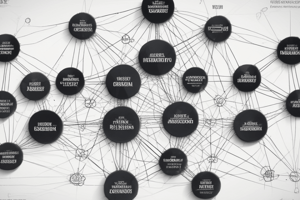Podcast
Questions and Answers
What is the main purpose of organizational structure?
What is the main purpose of organizational structure?
- To increase bureaucracy within the organization
- To create a complex work environment
- To limit the authority of managers
- To enable efficient production and delivery of the organization's outputs (correct)
According to the text, what does formalization in organizational structure refer to?
According to the text, what does formalization in organizational structure refer to?
- The extent to which authority to make decisions lies with the top of the organization
- The extent to which written rules, procedures, instructions, and communications are set out for employees (correct)
- The extent to which an organization uses regularly occurring procedures that are supported by bureaucratic procedures
- The extent to which there are different specialist roles and how they are distributed
What is the main focus of organizational design?
What is the main focus of organizational design?
- To impress the organization's various stakeholders
- To establish standardized work procedures
- To create a complex managerial hierarchy
- To provide managerial responses to environmental contingencies (correct)
What is a characteristic of network organizations?
What is a characteristic of network organizations?
What is a challenge of managing lateral relationships in network structures?
What is a challenge of managing lateral relationships in network structures?
What is a characteristic of virtual organizations?
What is a characteristic of virtual organizations?
According to Actor-Network Theory (ANT), what is the role of interessement?
According to Actor-Network Theory (ANT), what is the role of interessement?
What is the primary focus of Institutional Theory?
What is the primary focus of Institutional Theory?
How does Chandler's Strategy-Structure thesis differ from the perspective of Amburgey and Dacin?
How does Chandler's Strategy-Structure thesis differ from the perspective of Amburgey and Dacin?
According to Derek Pugh and colleagues, which of the following is NOT an underlying dimension of organizational structure?
According to Derek Pugh and colleagues, which of the following is NOT an underlying dimension of organizational structure?
Which structural form is characterized by rational legal authority, the idea of office, and impersonal order?
Which structural form is characterized by rational legal authority, the idea of office, and impersonal order?
What type of structures reduce the number of levels while retaining the same number of staff?
What type of structures reduce the number of levels while retaining the same number of staff?
What type of organization design involves overlaying a hierarchical structure with a horizontal one around big projects?
What type of organization design involves overlaying a hierarchical structure with a horizontal one around big projects?
Which organizational form operates primarily through project teams with functional departments having a supporting role?
Which organizational form operates primarily through project teams with functional departments having a supporting role?
What are the disadvantages of matrix structures mentioned in the text?
What are the disadvantages of matrix structures mentioned in the text?
What are the seven forces driving organizations, according to Mintzberg?
What are the seven forces driving organizations, according to Mintzberg?
Which organizational form is characterized by high complexity and formalization, low centralization, and trained specialists for core work?
Which organizational form is characterized by high complexity and formalization, low centralization, and trained specialists for core work?
What influences organizational structure and production systems according to the text?
What influences organizational structure and production systems according to the text?
Which force encourages standardization and formalization within organizations?
Which force encourages standardization and formalization within organizations?
What do informational technology systems support within organizations according to the text?
What do informational technology systems support within organizations according to the text?
Flashcards are hidden until you start studying
Study Notes
- Mintzberg's "forces" and "forms" and their roles in strategy and organization.
- Seven forces driving organizations: direction, efficiency, proficiency, concentration, innovation, cooperation, and competition.
- Forces for direction and efficiency: strategic vision, balancing costs and benefits, encourages standardization and formalization.
- Forces for proficiency, concentration, innovation: high levels of knowledge and skills, serving particular markets, searching for new products or services.
- Forces for cooperation and competition: pulling together ideology and culture, pulling apart policies and non-legitimate behavior.
- Mintzberg's "organizational forms": entrepreneurial, machine, professional, adhocracy, and diverse.
- Entrepreneurial form: low formalization and standardization, high centralization, authority located in a single person.
- Machine form: high formalization and standardization, centralized authority vested in rules and regulations, functional departments.
- Professional form: high complexity and formalization, low centralization, trained specialists for core work.
- Adhocracy form: very low standardization and formalization, little hierarchy, much use of temporary project teams.
- Diverse form: a combination of functions and products, with products dominating.
- Other influences on structure: size, technology, and informational technology.
- Size: positively correlated to overall role specialization and formalization of procedures.
- Technology: influences organizational structure and production systems.
- Informational technology: gives managers the ability to push information closer to the point of use, increases responsibility on employees, supports decentralization and matrix structures, and reduces hierarchy.
- External and environmental influences: the choice of organizational structure depends on the capacity, stability, and complexity of the environment.
- Socio-cultural influences: employees' desire for more flexible ways of organizing their work-life balance.
Studying That Suits You
Use AI to generate personalized quizzes and flashcards to suit your learning preferences.




